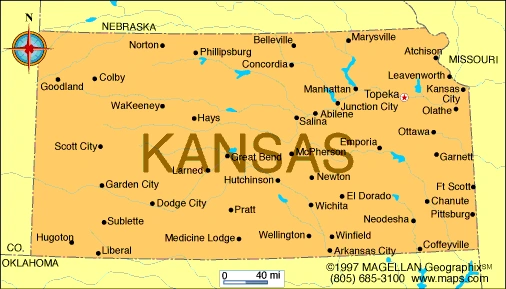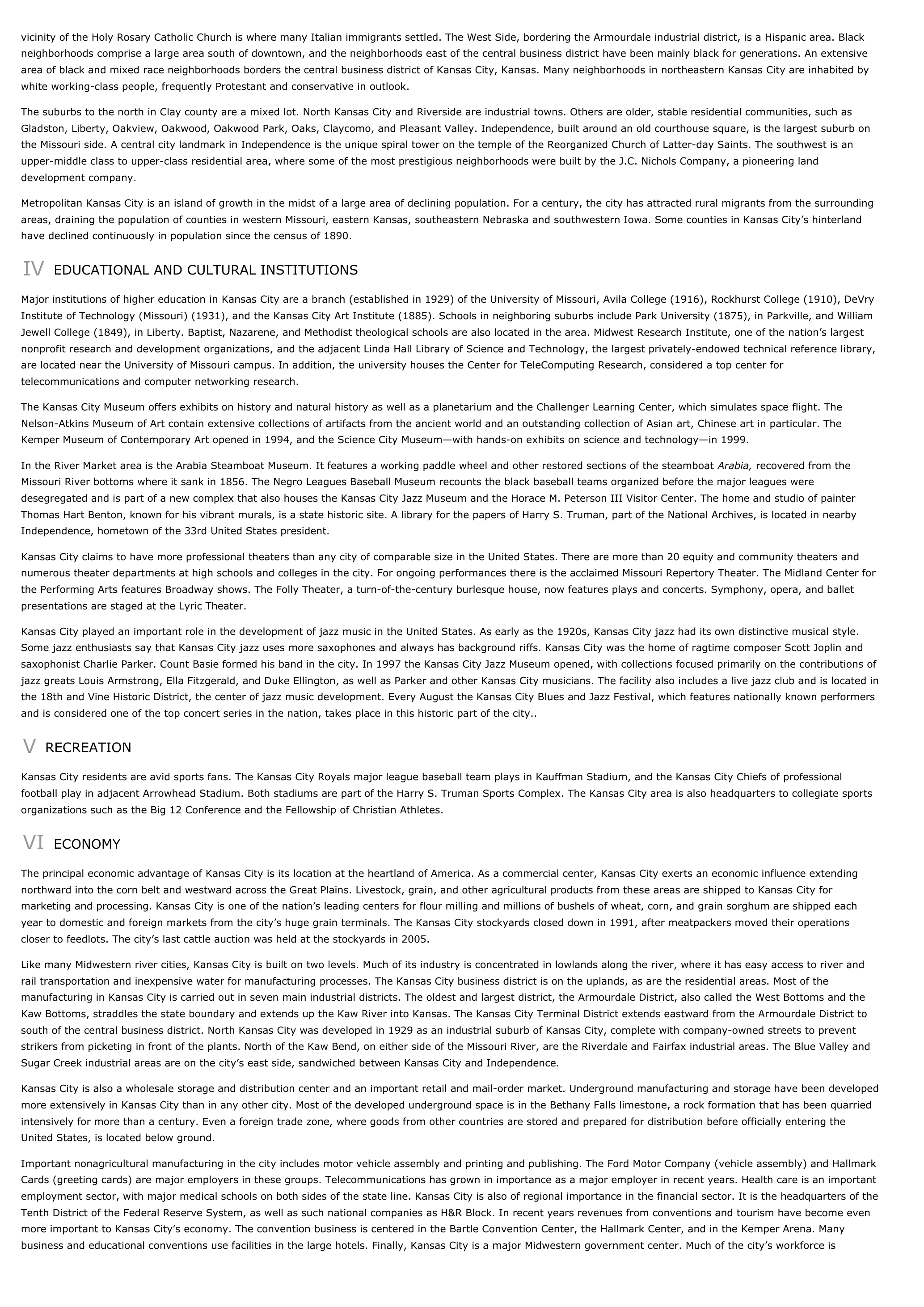Kansas City (Missouri) - geography.
Publié le 27/05/2013

Extrait du document


«
vicinity of the Holy Rosary Catholic Church is where many Italian immigrants settled.
The West Side, bordering the Armourdale industrial district, is a Hispanic area.
Blackneighborhoods comprise a large area south of downtown, and the neighborhoods east of the central business district have been mainly black for generations.
An extensivearea of black and mixed race neighborhoods borders the central business district of Kansas City, Kansas.
Many neighborhoods in northeastern Kansas City are inhabited bywhite working-class people, frequently Protestant and conservative in outlook.
The suburbs to the north in Clay county are a mixed lot.
North Kansas City and Riverside are industrial towns.
Others are older, stable residential communities, such asGladston, Liberty, Oakview, Oakwood, Oakwood Park, Oaks, Claycomo, and Pleasant Valley.
Independence, built around an old courthouse square, is the largest suburb onthe Missouri side.
A central city landmark in Independence is the unique spiral tower on the temple of the Reorganized Church of Latter-day Saints.
The southwest is anupper-middle class to upper-class residential area, where some of the most prestigious neighborhoods were built by the J.C.
Nichols Company, a pioneering landdevelopment company.
Metropolitan Kansas City is an island of growth in the midst of a large area of declining population.
For a century, the city has attracted rural migrants from the surroundingareas, draining the population of counties in western Missouri, eastern Kansas, southeastern Nebraska and southwestern Iowa.
Some counties in Kansas City’s hinterlandhave declined continuously in population since the census of 1890.
IV EDUCATIONAL AND CULTURAL INSTITUTIONS
Major institutions of higher education in Kansas City are a branch (established in 1929) of the University of Missouri, Avila College (1916), Rockhurst College (1910), DeVryInstitute of Technology (Missouri) (1931), and the Kansas City Art Institute (1885).
Schools in neighboring suburbs include Park University (1875), in Parkville, and WilliamJewell College (1849), in Liberty.
Baptist, Nazarene, and Methodist theological schools are also located in the area.
Midwest Research Institute, one of the nation’s largestnonprofit research and development organizations, and the adjacent Linda Hall Library of Science and Technology, the largest privately-endowed technical reference library,are located near the University of Missouri campus.
In addition, the university houses the Center for TeleComputing Research, considered a top center fortelecommunications and computer networking research.
The Kansas City Museum offers exhibits on history and natural history as well as a planetarium and the Challenger Learning Center, which simulates space flight.
TheNelson-Atkins Museum of Art contain extensive collections of artifacts from the ancient world and an outstanding collection of Asian art, Chinese art in particular.
TheKemper Museum of Contemporary Art opened in 1994, and the Science City Museum—with hands-on exhibits on science and technology—in 1999.
In the River Market area is the Arabia Steamboat Museum.
It features a working paddle wheel and other restored sections of the steamboat Arabia, recovered from the Missouri River bottoms where it sank in 1856.
The Negro Leagues Baseball Museum recounts the black baseball teams organized before the major leagues weredesegregated and is part of a new complex that also houses the Kansas City Jazz Museum and the Horace M.
Peterson III Visitor Center.
The home and studio of painterThomas Hart Benton, known for his vibrant murals, is a state historic site.
A library for the papers of Harry S.
Truman, part of the National Archives, is located in nearbyIndependence, hometown of the 33rd United States president.
Kansas City claims to have more professional theaters than any city of comparable size in the United States.
There are more than 20 equity and community theaters andnumerous theater departments at high schools and colleges in the city.
For ongoing performances there is the acclaimed Missouri Repertory Theater.
The Midland Center forthe Performing Arts features Broadway shows.
The Folly Theater, a turn-of-the-century burlesque house, now features plays and concerts.
Symphony, opera, and balletpresentations are staged at the Lyric Theater.
Kansas City played an important role in the development of jazz music in the United States.
As early as the 1920s, Kansas City jazz had its own distinctive musical style.Some jazz enthusiasts say that Kansas City jazz uses more saxophones and always has background riffs.
Kansas City was the home of ragtime composer Scott Joplin andsaxophonist Charlie Parker.
Count Basie formed his band in the city.
In 1997 the Kansas City Jazz Museum opened, with collections focused primarily on the contributions ofjazz greats Louis Armstrong, Ella Fitzgerald, and Duke Ellington, as well as Parker and other Kansas City musicians.
The facility also includes a live jazz club and is located inthe 18th and Vine Historic District, the center of jazz music development.
Every August the Kansas City Blues and Jazz Festival, which features nationally known performersand is considered one of the top concert series in the nation, takes place in this historic part of the city..
V RECREATION
Kansas City residents are avid sports fans.
The Kansas City Royals major league baseball team plays in Kauffman Stadium, and the Kansas City Chiefs of professionalfootball play in adjacent Arrowhead Stadium.
Both stadiums are part of the Harry S.
Truman Sports Complex.
The Kansas City area is also headquarters to collegiate sportsorganizations such as the Big 12 Conference and the Fellowship of Christian Athletes.
VI ECONOMY
The principal economic advantage of Kansas City is its location at the heartland of America.
As a commercial center, Kansas City exerts an economic influence extendingnorthward into the corn belt and westward across the Great Plains.
Livestock, grain, and other agricultural products from these areas are shipped to Kansas City formarketing and processing.
Kansas City is one of the nation’s leading centers for flour milling and millions of bushels of wheat, corn, and grain sorghum are shipped eachyear to domestic and foreign markets from the city’s huge grain terminals.
The Kansas City stockyards closed down in 1991, after meatpackers moved their operationscloser to feedlots.
The city’s last cattle auction was held at the stockyards in 2005.
Like many Midwestern river cities, Kansas City is built on two levels.
Much of its industry is concentrated in lowlands along the river, where it has easy access to river andrail transportation and inexpensive water for manufacturing processes.
The Kansas City business district is on the uplands, as are the residential areas.
Most of themanufacturing in Kansas City is carried out in seven main industrial districts.
The oldest and largest district, the Armourdale District, also called the West Bottoms and theKaw Bottoms, straddles the state boundary and extends up the Kaw River into Kansas.
The Kansas City Terminal District extends eastward from the Armourdale District tosouth of the central business district.
North Kansas City was developed in 1929 as an industrial suburb of Kansas City, complete with company-owned streets to preventstrikers from picketing in front of the plants.
North of the Kaw Bend, on either side of the Missouri River, are the Riverdale and Fairfax industrial areas.
The Blue Valley andSugar Creek industrial areas are on the city’s east side, sandwiched between Kansas City and Independence.
Kansas City is also a wholesale storage and distribution center and an important retail and mail-order market.
Underground manufacturing and storage have been developedmore extensively in Kansas City than in any other city.
Most of the developed underground space is in the Bethany Falls limestone, a rock formation that has been quarriedintensively for more than a century.
Even a foreign trade zone, where goods from other countries are stored and prepared for distribution before officially entering theUnited States, is located below ground.
Important nonagricultural manufacturing in the city includes motor vehicle assembly and printing and publishing.
The Ford Motor Company (vehicle assembly) and HallmarkCards (greeting cards) are major employers in these groups.
Telecommunications has grown in importance as a major employer in recent years.
Health care is an importantemployment sector, with major medical schools on both sides of the state line.
Kansas City is also of regional importance in the financial sector.
It is the headquarters of theTenth District of the Federal Reserve System, as well as such national companies as H&R Block.
In recent years revenues from conventions and tourism have become evenmore important to Kansas City’s economy.
The convention business is centered in the Bartle Convention Center, the Hallmark Center, and in the Kemper Arena.
Manybusiness and educational conventions use facilities in the large hotels.
Finally, Kansas City is a major Midwestern government center.
Much of the city’s workforce is.
»
↓↓↓ APERÇU DU DOCUMENT ↓↓↓
Liens utiles
- Kansas City (Missouri) - geography.
- Beery Wallace, 1885-1949, né à Kansas City (Missouri), acteur américain.
- St. Louis (city) - geography. I INTRODUCTION Skyline of St. Louis, Missouri St. Louis,
- Kansas City (Missouri).
- Watson T om , né en 1949 à Kansas City, joueur de golf américain.

































